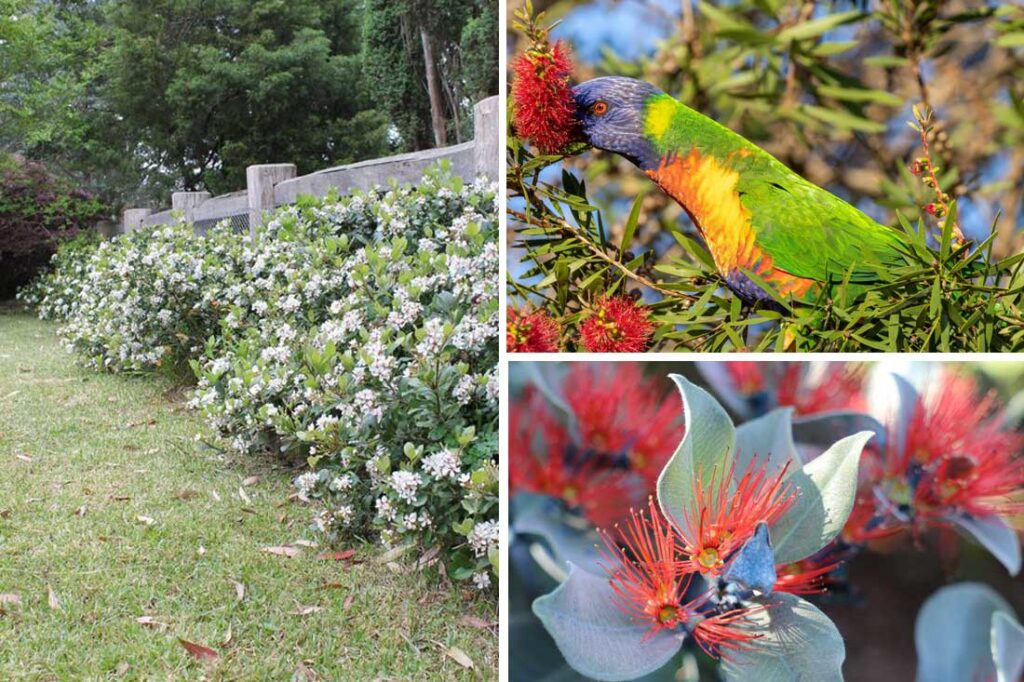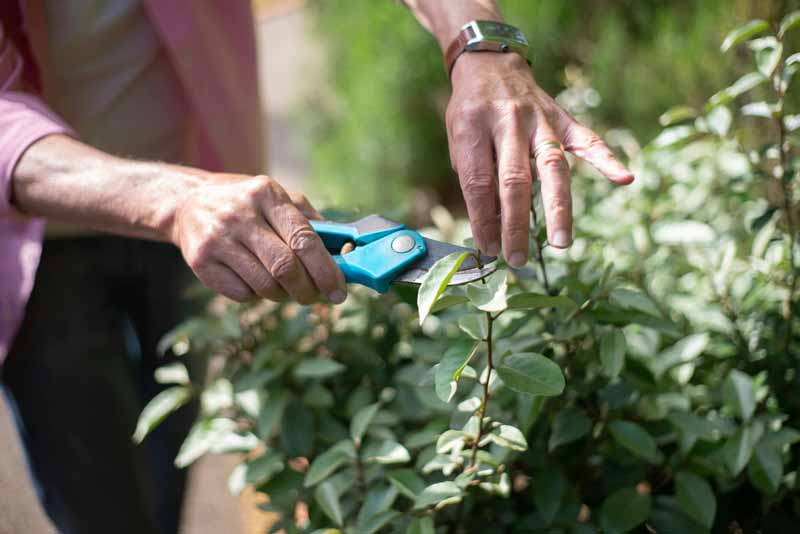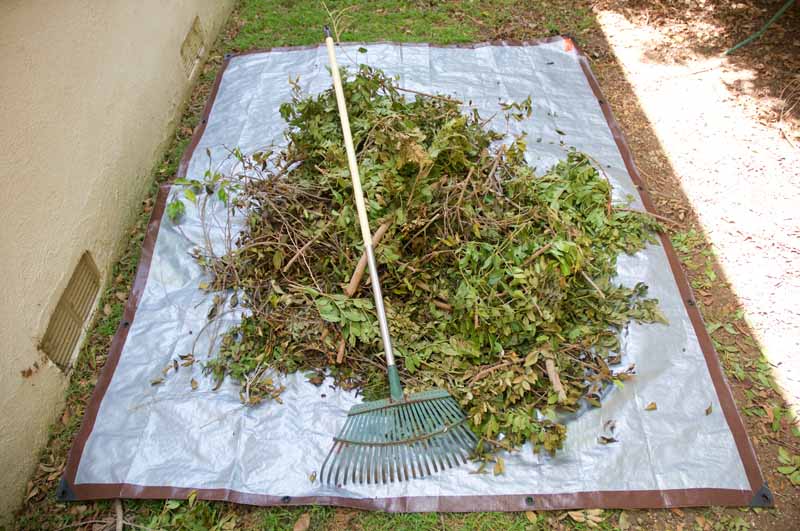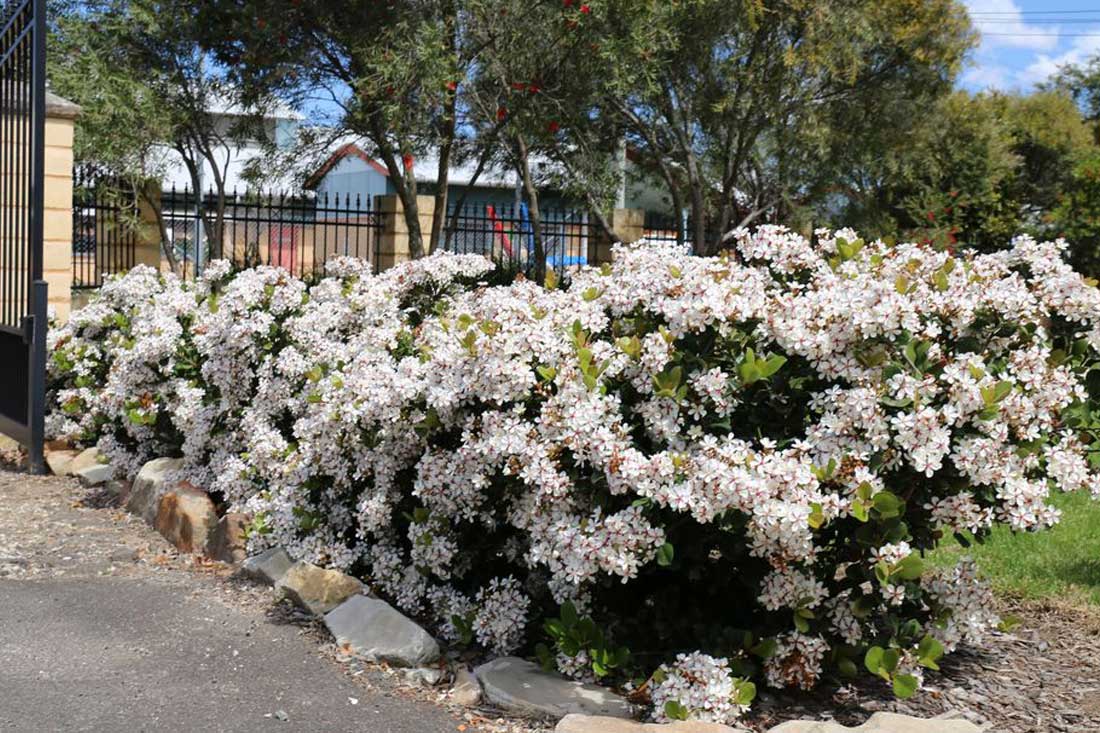Introduction
Have you ever considered that the hedges you plant could be a bustling hub of activity for the local pollinator population? Choosing the right types of hedges can significantly enhance your garden’s contribution to local biodiversity by supporting various pollinators.
This article explores hedging plant selections that not only provide privacy and aesthetic appeal but also serve as vital resources for pollinators. We’ll explore a range of native and exotic plants that are particularly attractive to generalist pollinators, offering practical advice for gardeners, landscape architects, designers and landscapers.
We explore flowering timelines for each plant genus we discuss, but it’s important to remember that some species and cultivars within each genus will perform differently due to their own specific breeding and environmental pressures. Make sure you check online information and read plant labels to see information from the plant breeder regarding when each variety flowers.
Also keep in mind that flowers aren’t the only resource for our native fauna: fruits, seeds, and even buds, leaves and stems are all food sources within a garden. Not to mention habitat, without which a food source is pointless in the first place.
Pollinators come in all shapes and sizes, from the tiniest micro wasp to the largest, most rugged possum. This rainbow lorikeet is pollinating a callistemon, taking valuable sugars from the nectar and protein from the pollen.
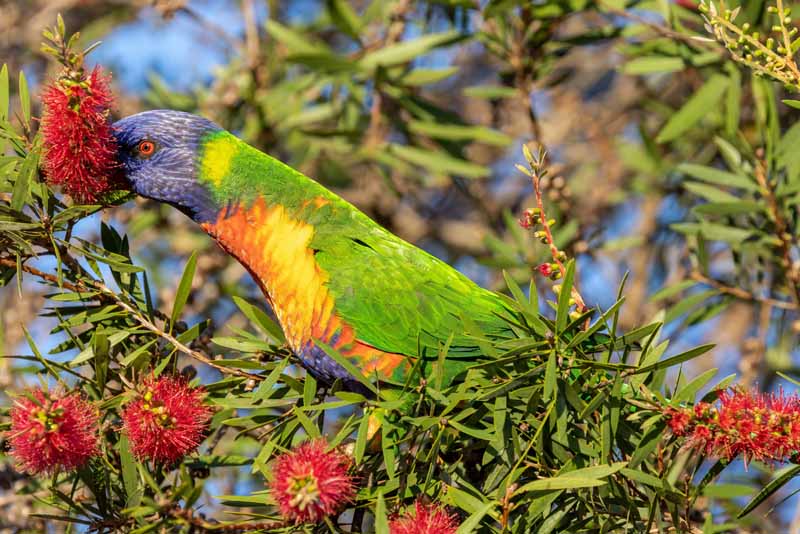
Benefits of Pollinators in the Garden
Understanding Pollinators and Their Importance
Pollinators include a wide array of species, from bees and butterflies to birds and bats, all playing their own role in ecosystems by aiding in the pollination of many plants, including those important for food production. Each link in the food chain feeds predators above them, and help to break down nutrients into a form that plants can uptake.
In gardens, pollinators help increase the yield of fruit and vegetable crops and are essential for the reproduction of many ornamental plants (especially annuals). While some pollinators have specific plant preferences, our native generalist pollinators visit a variety of flowers, contributing to the cross-pollination and genetic diversity of plants. Flowering hedges can attract beneficial insects such as micro wasps, hoverflies, and predatory beetiles, enhancing the garden’s health and biodiversity.
Some pollinators, such as many types of micro wasp and hoverflies, feed on nectar in their adult stage, while their larvae feed on pests such as aphids and caterpillars.
Pollinators are generally most active in the warmer months, particularly in cooler climates. This means your garden should be full of flowers from September to March if you intend to attract them to your garden. However, don’t forget about the other times of year – coreas, grevilleas, aloes, banksias are examples of plants that flower in the cooler months to feed the pollinators that do happen to be active during those times (including birds).
Benefits of Pollinator-Friendly Hedges
While the primary aim of a garden might not be fruit production, the benefits of incorporating pollinator-friendly hedges extend far beyond pollination services. These hedges offer aesthetic beauty, act as effective screens for privacy, reduce wind and noise, and play a role in supporting both vertebrate and invertebrate wildlife.
A number of pollinating insects and their larvae act as natural pest controllers and assist in the decomposition process, enriching the soil. Moreover, while native plants are often recommended for attracting local pollinators, many exotic species can also provide essential resources for these same local pollinators.
Viburnum spp.
Overview of Viburnum as a Pollinator-Friendly Hedge
Viburnum species offer a splendid combination of dense foliage and attractive flowers, making them an exceptional choice for gardeners and landscapers looking to establish hedges that not only provide privacy but also support pollinator populations. These versatile shrubs can adapt to various environmental conditions, making them suitable for a wide range of landscapes.
Why It’s a Good Pollinator Plant
Viburnum species are renowned for their ability to attract a myriad of pollinators, including bees, butterflies, and other beneficial insects. This is due to their large, often fragrant flowers that provide an abundant source of nectar and pollen. The dense foliage also offers shelter for pollinators, enhancing their habitat and encouraging biodiversity within the garden.
What Seasons Do These Plants Typically Flower
The flowering period of Viburnum species varies, but many are known to bloom from early spring through to late summer, offering a prolonged source of nectar during the critical months when pollinators are most active. This extended flowering season is particularly beneficial in supporting a healthy and diverse population of pollinators in the garden.
Featured Viburnum Cultivars for Enhanced Pollinator Attraction
Quick Fence™ Viburnum odoratissimum ‘VOQ1’ PBR: Specifically bred for rapid growth and a dense habit, the Quick Fence™ cultivar provides an immediate and attractive hedging solution. Its glossy leaves and fragrant white flowers not only add aesthetic appeal but also serve as an excellent resource for pollinators. For more information, visit Quick Fence™.
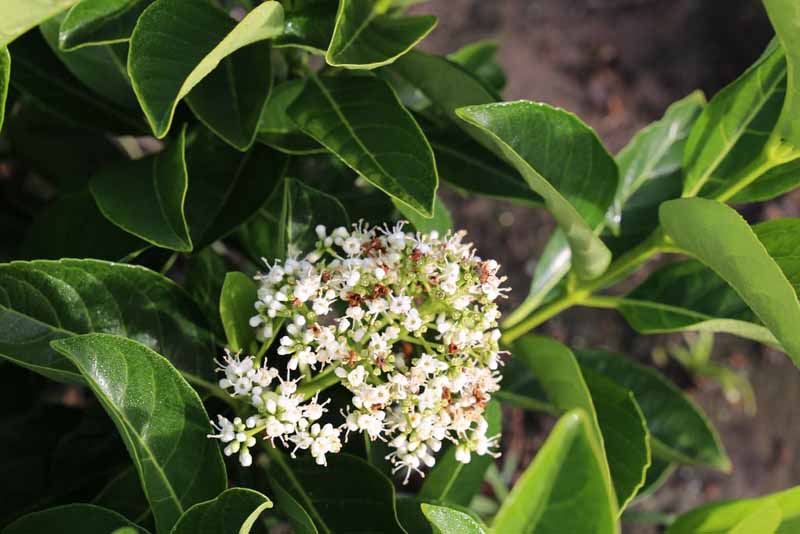
Dense Fence™ Viburnum odoratissimum ‘VOC1’ PBR: As the name suggests, this cultivar is celebrated for its dense, compact growth, making it ideal for creating privacy screens or formal hedges. The Dense Fence™ also blooms with clusters of aromatic white flowers, attracting various pollinators to the garden. Details can be found at Dense Fence™ Viburnum.
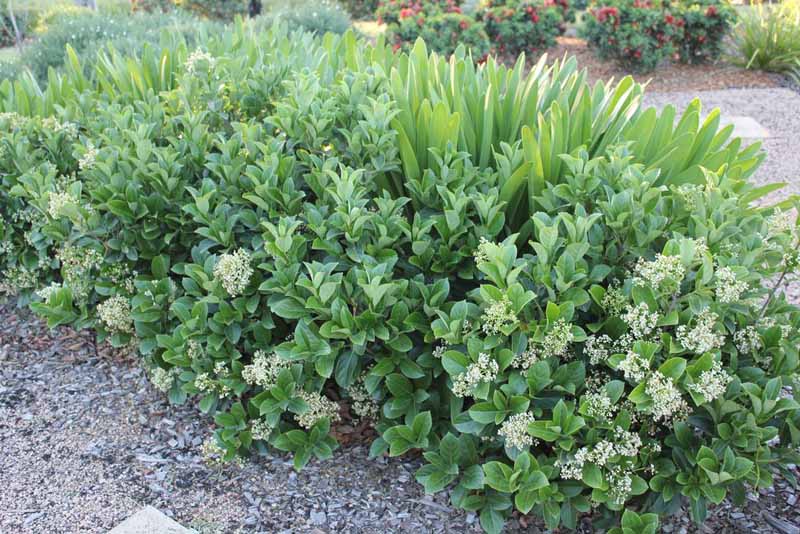
Photinia spp.
Characteristics of Photinia that Make It Appealing to Pollinators
Photinia species are beloved for their striking red foliage and the white flowers they produce, which are not only visually appealing to humans but also highly attractive to pollinators. The glossy leaves, often emerging bright red before maturing to green, provide a stunning contrast in the garden throughout the year. When in bloom, the clusters of small, fragrant white flowers offer an abundant source of nectar and pollen, drawing in bees, butterflies, and other beneficial insects.
Why It’s a Good Pollinator Plant
The allure of Photinia to pollinators lies in its generous provision of food resources. The flowers are rich in nectar, making them a favoured destination for bees and butterflies in search of energy. Additionally, the dense canopy formed by these shrubs offers shelter to pollinators, creating a microhabitat within the garden that supports their lifecycle. By planting Photinia, gardeners contribute to the conservation of pollinator populations, which are crucial for the pollination of many other plants.
What Seasons Do These Plants Typically Flower
Photinia typically adorns gardens with its beautiful blooms in late spring to early summer. This timing is particularly advantageous as it coincides with the peak activity period of many pollinators. The flowering season of Photinia provides a critical food source during a time when pollinators are actively foraging and contributing to the pollination of plants across the landscape.
Featured Cultivar: Thin Red™ Photinia x fraseri ‘NP01’ PBR
Among the various cultivars of Photinia, the Thin Red™ stands out for its unique attributes tailored to modern landscaping needs. Characterised by its narrow growth habit and vibrant red new growth, the Thin Red™ offers a visually striking addition to gardens and hedging projects while maintaining a compact form. Its flowers, like those of other Photinia species, are a magnet for pollinators, combining aesthetic appeal with ecological benefits. For further details on this cultivar, visit Thin Red™ Photinia.
Rhaphiolepis spp.
Introduction to Rhaphiolepis and Its Benefits for Pollinators
Rhaphiolepis, commonly referred to as Indian Hawthorn, is a genus of evergreen shrubs known for its resilience, low maintenance, and particularly for its role in supporting pollinator populations. These plants are not only appreciated for their aesthetic appeal, characterised by glossy leaves and abundant flowers, but also for their ability to provide critical resources for pollinators.
Why It’s a Good Pollinator Plant
The value of Rhaphiolepis as a pollinator plant lies in its dense clusters of fragrant flowers, which bloom profusely and offer nectar and pollen in abundance. These resources are vital for bees, butterflies, and other pollinating insects, facilitating their survival and proliferation. Because of their robust nature, they provide a reliable source of sustenance for pollinators across various environments, including areas that other plants struggle.
What Seasons Do These Plants Typically Flower
Rhaphiolepis plants typically flower from late winter or early spring into summer, presenting a timely source of nourishment for pollinators emerging from the colder months. This period is crucial as it precedes the full bloom of many other garden plants, making Rhaphiolepis an invaluable early-season food supply for pollinating insects.
Featured Cultivars: Cosmic Pink™ and Cosmic White™ Rhaphiolepis
Among the Rhaphiolepis species, two cultivars stand out for their exceptional qualities: Cosmic Pink™ Rhaphiolepis indica ‘RAPH02’ PBR and Cosmic White™ Rhaphiolepis indica ‘RAPH01’ PBR. Both varieties offer unique benefits tailored to modern gardening and landscaping needs.
Cosmic Pink™ Rhaphiolepis indica ‘RAPH02’ PBR: Renowned for its vibrant pink flowers, this cultivar adds a splash of colour to gardens while serving as an attractive source of nectar for pollinators. The Cosmic Pink™ combines beauty with functionality, creating a pollinator-friendly environment with visual appeal. For more information, visit Cosmic Pink™.
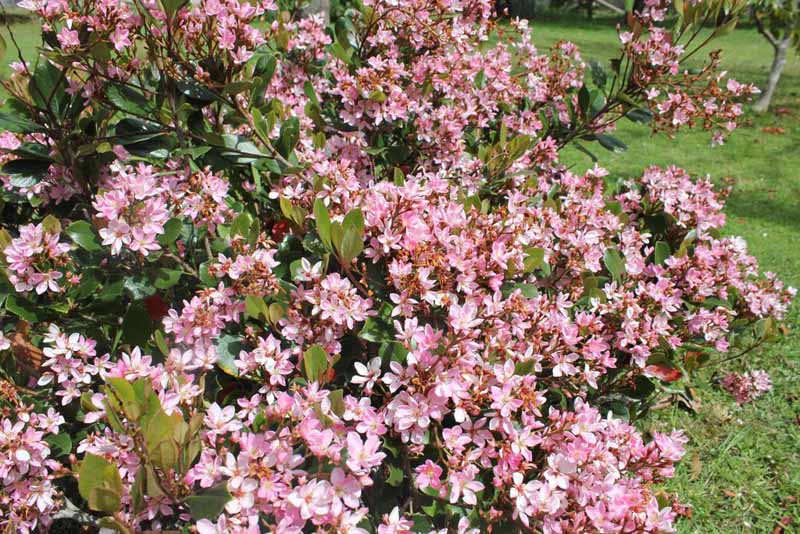
Cosmic White™ Rhaphiolepis indica ‘RAPH01’ PBR: This cultivar is distinguished by its large, white flowers that not only enhance the aesthetic of any garden but also play a crucial role in attracting and feeding pollinators. The Cosmic White™ is an excellent choice for those looking to support biodiversity while enjoying stunning floral displays. Details can be found at Cosmic White™.

Metrosideros spp.
The Role of Metrosideros in Supporting Pollinator Populations
Metrosideros, or the New Zealand Christmas bush, is a genus within the Myrtaceae family (along with eucalypts, lilly pillies and bottlebrushes) comprising species of evergreen trees and shrubs. Known for their resilience and vibrant flowers, these plants serve as a beacon for birds, bees, butterflies, and other generalist pollinating insects, offering them a haven for feeding and nesting.
Why It’s a Good Pollinator Plant
Metrosideros species are exceptional pollinator plants due to the rich nectar and pollen their flowers produce. The vivid, often crimson, blossoms are not only visually striking but also highly attractive to a wide range of pollinating insects. This allure is crucial for the survival of many pollinator species, especially in urban and suburban settings where natural resources are increasingly scarce. Furthermore, the dense foliage of Metrosideros provides shelter for pollinators, enhancing their habitat and supporting their lifecycle.
What Seasons Do These Plants Typically Flower
The flowering season of Metrosideros varies slightly among species, but most commonly, these plants burst into bloom from late spring through to summer. This timing is particularly beneficial as it ensures a continuous supply of nectar and pollen during a critical period of pollinator activity.
Velvet Sky™ Metrosideros collina ‘MB01’ PBR
A noteworthy cultivar within the Metrosideros genus is Velvet Sky™ Metrosideros collina ‘MB01’ PBR, distinguished by its unique, velvety, deep purple foliage and bright red flowers. Velvet Sky™ offers a stunning visual contrast in gardens and landscapes, while also serving as an invaluable resource for pollinators. The intense colour of its blooms acts as a magnet for bees and butterflies, ensuring that Velvet Sky™ is more than just an ornamental addition to gardens—it’s a vital part of the ecosystem supporting pollinator health. For further details on this cultivar, visit Velvet Sky™ Metrosideros.

Murraya spp.
Benefits of Planting Murraya as a Hedge for Pollinators
The genus Murraya, particularly when utilised as a hedge, offers numerous advantages not only for garden aesthetics but also for supporting diverse pollinator populations. These plants are renowned for their dense, glossy foliage and the sweet fragrance of their flowers, which can transform any garden into a haven for beneficial insects. By choosing Murraya spp. for hedges, gardeners create a continuous floral barrier that serves dual purposes: offering privacy and acting as a corridor for pollinators to safely navigate and feed.
Why It’s a Good Pollinator Plant
Murraya spp. stand out as excellent pollinator plants due to their abundant and highly fragrant blooms, which are rich in nectar. These characteristics make them highly attractive to bees, butterflies, and other pollinating insects. The dense foliage also provides essential shelter and nesting sites, further enhancing their habitat. Moreover, while most cultivars are fast-growing and require a lot of pruning, other varieties are slower-growing and support biodiversity with minimal effort.
What Seasons Do These Plants Typically Flower
Murraya spp. are known for their generous flowering periods, typically blooming heavily in spring and summer, with sporadic flowering throughout the year in warmer climates. This extended blooming period ensures that pollinators have access to a reliable source of nectar and pollen over several months, which is crucial for their survival and thriving populations.
Sweet Privacy™ Murraya paniculata ‘MP01’ PBR
One cultivar that epitomises the best qualities of the Murraya genus is Sweet Privacy™ Murraya paniculata ‘MP01’ PBR. This particular variety has been selected for its compact growth habit, making it ideal for hedges and screens in both residential and commercial landscapes. The Sweet Privacy™ cultivar boasts lush, green foliage and an abundance of white, fragrant flowers that bloom profusely, providing a sensory experience and an invaluable resource for pollinators. Its adaptability to a range of soil types and conditions, coupled with its disease resistance, makes Sweet Privacy™ an outstanding choice for gardeners and landscape professionals alike. For further details on this cultivar, visit Sweet Privacy™ Murraya.
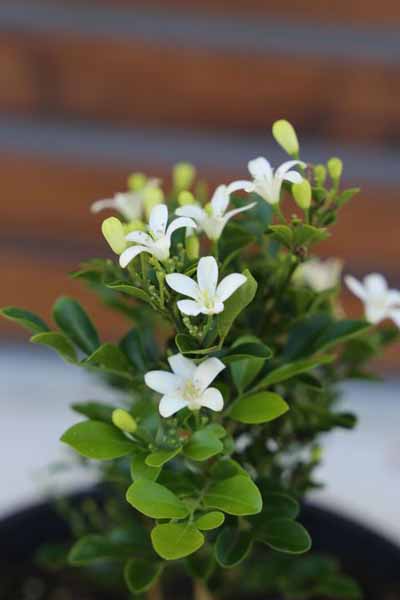
Callistemon spp.
Overview of Callistemon’s Contribution to Pollinator-Friendly Gardens
Callistemon spp., commonly known as bottlebrush, are a classic option for those designing pollinator-friendly gardens. These plants are beloved not only for their striking cylindrically-organised, brush-like flowers but also for their ability to attract a wide variety of pollinators, including insects, birds, bats, and more.
Why It’s a Good Pollinator Plant
The value of Callistemon as a pollinator plant lies in its prolific flowering habit and the high nectar yield of its blooms. The flowers, ranging in colour from vivid reds to pinks and even greens, produce plenty of nectar and are densely packed with stamens, each a tiny pollen-filled vessel. This abundance ensures that pollinators can efficiently gather food over the blooming period. Moreover, Callistemon species are generally hardy and adaptable to a variety of conditions, making them excellent choices for sustainable gardens aimed at supporting ecosystems without too many inputs like water or fertilisers.
What Seasons Do These Plants Typically Flower
Callistemon species typically flower from spring through to summer, although some varieties may also offer sporadic blooms outside these seasons, depending on the climate. This seasonal flowering ensures a steady supply of nectar during critical periods of pollinator activity, contributing significantly to the health of local pollinator populations.
Featured Callistemon Cultivars
CANDY BURST™ Callistemon spp ‘CNU06’ PBR
The CANDY BURST™ cultivar is notable for its vibrant pink flowers that create a stunning visual impact while providing an excellent food source for pollinators. Its compact growth habit makes it an ideal choice for smaller gardens or as part of a mixed border. For more details, visit CANDY BURST™ Callistemon.
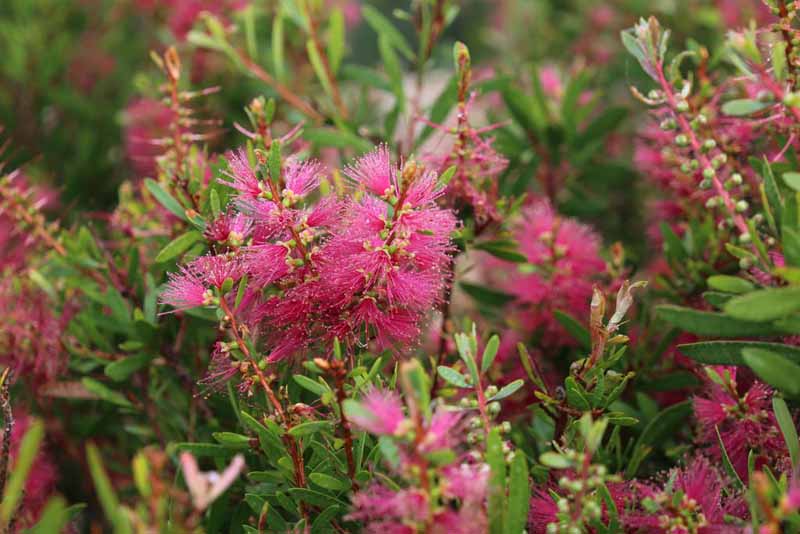
Green John™ Callistemon viminalis ‘LJ23’ PBR
Green John™ offers a unique aesthetic with its dense green foliage and contrasting red flowers. This cultivar is particularly suited for creating lush, informal hedges or screens that not only offer privacy but also support diverse pollinator species. More information can be found at Green John™ Callistemon.

Slim™ Callistemon viminalis ‘CV01’ PBR
Slim™ is designed for narrow spaces, offering the beauty and ecological benefits of Callistemon without requiring extensive room to grow. Its slender form and vibrant red flowers make it an excellent choice for tight planting areas or as a vertical accent in the landscape. Further details are available at Slim™ Callistemon.
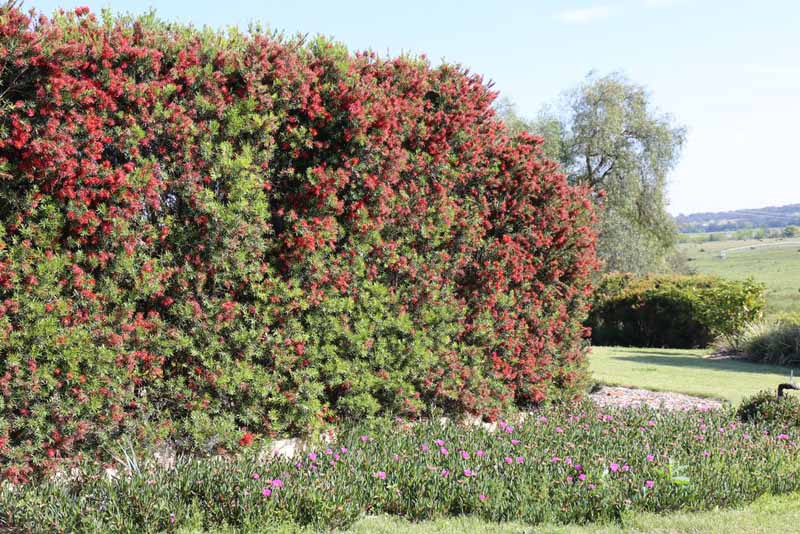
For those interested in exploring more varieties of this versatile and ecologically beneficial genus, a comprehensive selection can be browsed here: Ozbreed Native Shrubs and Groundcovers – Callistemon.
Lilly Pillies (Acmena spp., Syzygium spp., and Waterhousea spp.)
Lilly pillies, encompassing species from the genera Acmena (now reclassified into Syzygium), Syzygium, and Waterhousea, are valued for their versatility and ecological benefits in Australian gardens.
The Significance of Lilly Pillies in Supporting Local Pollinators
Lilly pillies play a crucial role in urban and suburban landscapes by providing essential resources for a variety of pollinators. Their dense foliage offers shelter, while their flowers supply nectar and pollen, contributing to a healthy ecosystem. By including lilly pillies in garden designs, gardeners, landscapers, designers and landscape architects can enhance biodiversity and promote a balanced environment.
Why It’s a Good Pollinator Plant
The key to lilly pillies’ success as pollinator plants lies in their prolific flowering habit. The small, often fragrant flowers form in clusters, making them accessible and attractive to bees, butterflies, and birds. This abundance of blooms ensures that pollinators have ample foraging opportunities, particularly during critical feeding times.
What Seasons Do These Plants Typically Flower
Lilly pillies typically flower from late spring to summer, although this can vary slightly between species and cultivars. This timing aligns well with the peak activity periods of many pollinators, making lilly pillies an invaluable addition to gardens focused on supporting these essential creatures.
Featured Cultivars
Straight and Narrow™ Syzygium australe ‘SAN01’ PBR
The Straight and Narrow™ cultivar is a standout for its columnar growth habit, making it an excellent choice for hedging or screening in tight spaces. Its compact size does not detract from its ecological value, as it still produces the characteristic clusters of white flowers that attract pollinators. More details can be found at Straight and Narrow™.
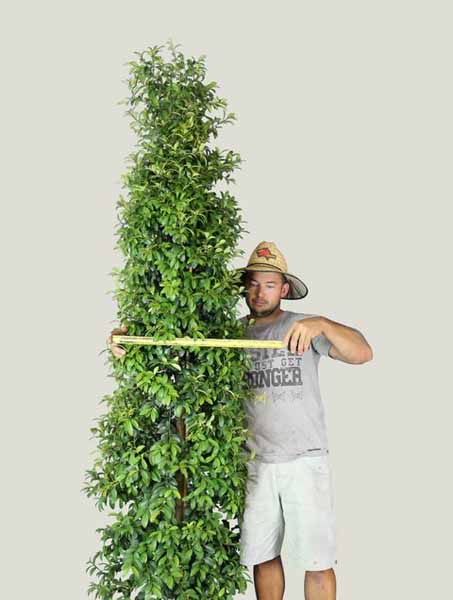
Sublime™ Acmena smithii ‘DOW30’ PBR
Sublime™ is a mid-sized tree known for its vibrant lime new growth and dense foliage, extending down to the ground. This cultivar not only offers visual appeal but also serves as a habitat and food source for pollinators with its subtle, yet abundant flowers. It flowers, but rarely produces berries. Further information is available at Sublime™ Acmena.
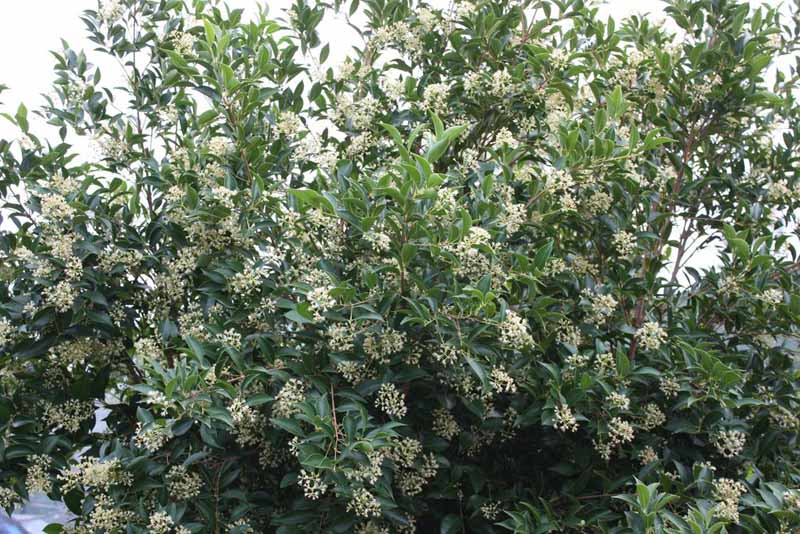
Sweeper® Waterhousea floribunda ‘DOW20’ PBR
Sweeper® stands out for its heavily weeping form and large clusters of white flowers that appear in summer. This cultivar provides an added aesthetic dimension to landscapes while supporting pollinators with its generous floral offerings. More details can be explored at Sweeper® Waterhousea.

Incorporating lilly pillies into garden and landscape designs offers a practical way to support pollinator populations while enhancing the beauty and biodiversity of outdoor spaces. By choosing cultivars such as Straight and Narrow™, Sublime™, and Sweeper® lilly pillies, professionals and hobby gardeners can achieve both aesthetic goals and ecological benefits, fostering environments where pollinators can thrive.
Westringia spp.
Westringia, commonly referred to as Australian rosemary due to its rosemary-like foliage, is a genus of Australian native plants that has garnered attention for its pollinator-friendly attributes and landscape versatility. These hardy shrubs are not only admired for their drought resistance and low-maintenance nature but also for their appeal to a variety of pollinators.
Introduction to Westringia and Its Pollinator Appeal
Westringia species are renowned for their resilience in various environmental conditions, from coastal locations to inland gardens. Their true value, however, lies in their ability to attract pollinators. The small, tubular flowers, which range in colour from white to mauve, are rich in nectar, making them an excellent resource for bees, butterflies, and other beneficial insects.
Why It’s a Good Pollinator Plant
The dense foliage and profusion of flowers make Westringia an ideal habitat for pollinators, providing shelter and sustenance throughout the year. The plants’ long flowering period ensures a consistent food source, crucial for the survival and proliferation of local pollinator populations. This continuous bloom cycle also contributes to the garden’s aesthetic, offering visual interest across seasons.
What Seasons Do These Plants Typically Flower
Westringia species are known for their extended blooming period, with most varieties flowering from early spring through to late autumn. Some species and cultivars may even exhibit flowers year-round in milder climates, ensuring a constant supply of nectar for pollinators.
Featured Cultivars
Grey Box™ Westringia fruticosa ‘WES04’ PBR
The Grey Box™ cultivar stands out for its compact growth habit and silver-grey foliage, making it an ideal choice for low hedges or borders. Its small, white flowers are a magnet for bees and other pollinators. Drought tolerance further enhances its utility in sustainable landscapes. More information can be found at Grey Box™.
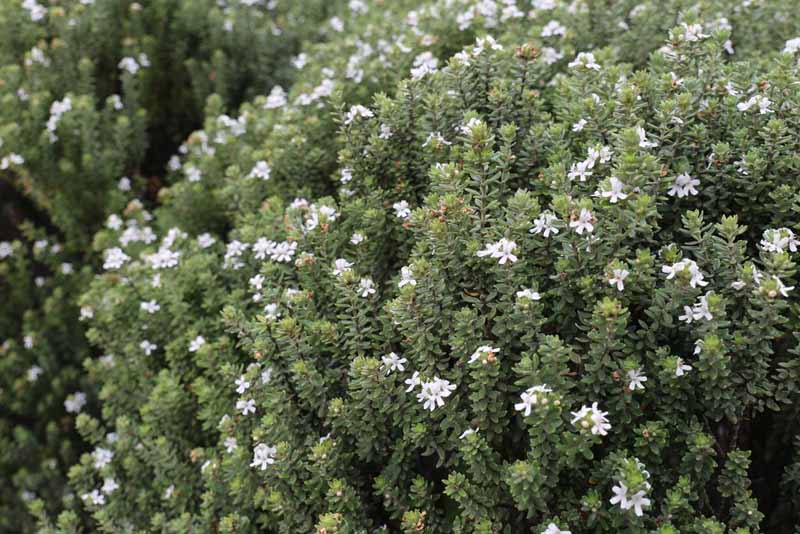
Naringa™ Westringia hybrid ‘WES01’ PBR
Naringa™ is lauded as the best medium to tall hedging plant among Westringia varieties, with its robust growth and prolific flowering habit. Its lavender flowers not only add a splash of colour but also support pollinator activity. Details are available at Naringa™.
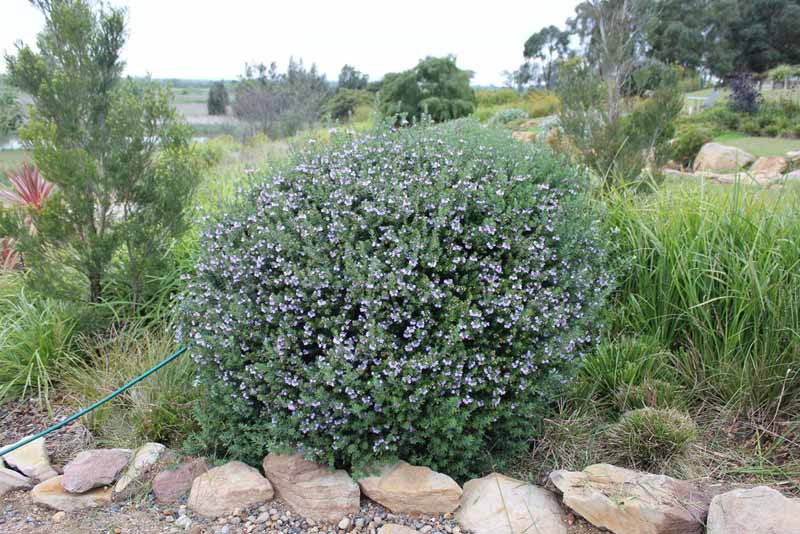
Low Horizon™ Westringia fruticosa ‘WES06’ PBR
For gardens requiring ground cover options, Low Horizon™ offers an ultra-compact form with dense, green foliage and white flowers that bloom profusely, creating a lush tapestry that benefits pollinators. Explore more at Low Horizon™.
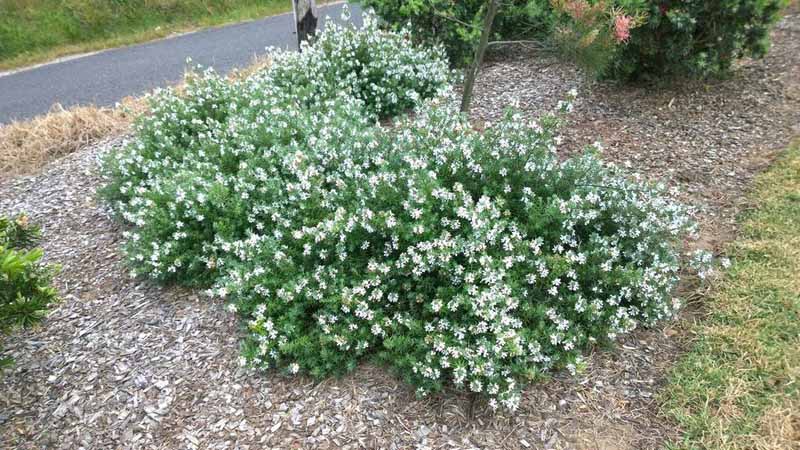
Grevillea spp.
Grevillea spp. are another mainstay in Aussie garens. This native genus comprises an array of species and cultivars that are not only visually stunning but also significantly beneficial to pollinators including insects and birds.
Grevillea’s Contribution to Attracting and Supporting Pollinators
Grevillea species are renowned for their intricate and vibrant flowers, which produce abundant nectar and pollen. These floral traits make them irresistible to a wide range of pollinators, including bees, birds, and butterflies. The plants serve as a vital food source, particularly during seasons when other nectar sources may be scarce, thus playing a crucial role in sustaining local pollinator populations.
Why It’s a Good Pollinator Plant
Most species are drought-resistant once established, making them suitable for a range of garden styles and climates. Additionally, the extended flowering period of many Grevillea species ensures a consistent supply of nectar and pollen, supporting pollinators throughout the year. Their open tubular flowers are attractive to insects and birds alike.
What Seasons Do These Plants Typically Flower
Grevillea spp. exhibit a broad flowering season, with many species blooming from winter through to early summer. However, some cultivars have been bred to extend this period, offering flowers for much of the year. This trait is especially valuable in creating gardens that provide continuous support to pollinators.
Featured Cultivars
Crimson Villea™ Grevillea rosmarinifolia ‘H16’ PBR
Crimson Villea™ is distinguished by its striking crimson flowers and compact growth habit, making it an excellent choice for small gardens or as a feature plant. Its long flowering season, from winter to spring and beyond, offers vital support to pollinators during these months. Further details can be explored at Crimson Villea™ Grevillea.
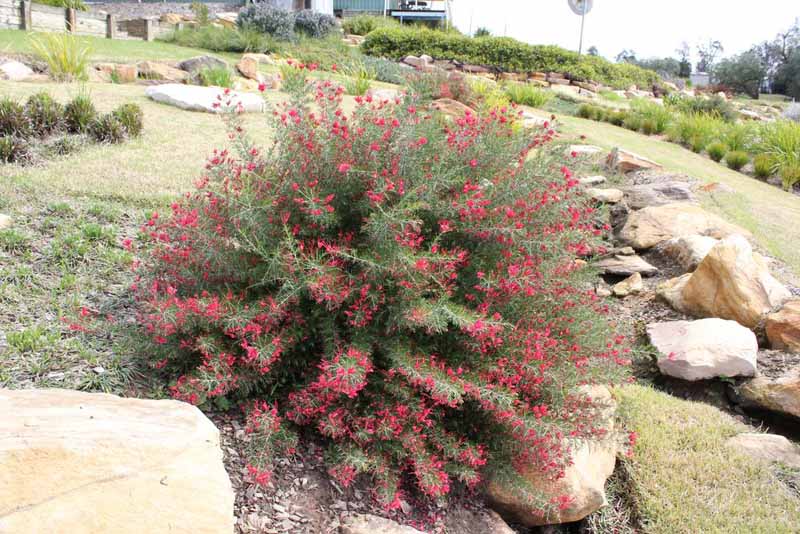
Cherry Cluster™ Grevillea rhyolitica x juniperina ‘TWD01’ PBR
Cherry Cluster™ is a ground cover that boasts dense clusters of cherry-red flowers, adding a burst of colour to the landscape. Its robust nature and adaptability to different soil types make it a versatile addition to any garden. The plant’s extended flowering period supports a diverse array of pollinators. More information is available at Cherry Cluster™ Grevillea.
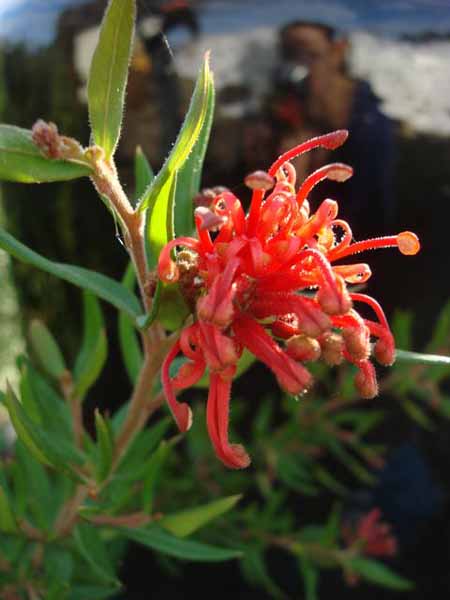
Gold Cluster™ Grevillea juniperina ‘H22’ PBR
Gold Cluster™ is another ground cover, known for its vibrant gold flowers that create a stunning display against its green foliage. This groundcover variety is particularly effective in attracting bees and offers a spectacular floral show from late winter to spring. Additional insights can be found at Gold Cluster™ Grevillea.
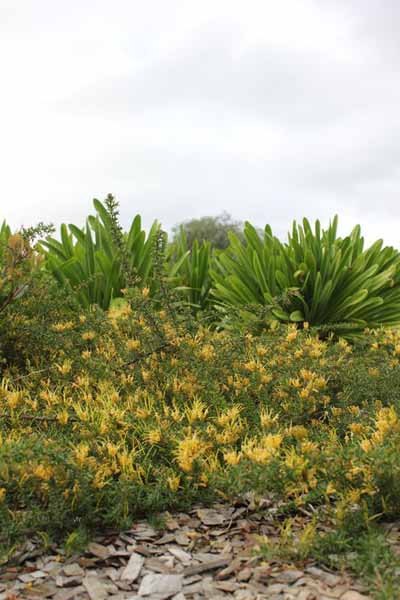
Conclusion
Selecting the right hedges for your garden involves more than considering their height and foliage. By choosing plants that attract and support pollinators, gardeners, landscape architects, and council decision-makers can make a significant positive impact on local ecosystems and biodiversity. This guide aims to encourage thoughtful plant selection that benefits not only our gardens but also the myriad of pollinators that depend on them. Integrating pollinator-friendly hedges into landscaping projects is a step towards creating more resilient and vibrant natural habitats in our communities.

